|
This section contains 1,305 words (approx. 4 pages at 400 words per page) |

|
Kippen is an educator and specialist on British colonial literature and twentieth-century South African fiction. In the following essay. he examines the many symmetrical reflections in Galsworthy's story and argues that they. together, create a larger rhetorical mirror directed outward at the reader.
At first blush, Galsworthy's "The Japanese Quince" seems quite simple; however, the story's superficial simplicity is deceptive. Mr. Nilson, a well-to-do man of commerce walks out, one fine spring day, into the Garden Square adjacent to his home. He ruminates on spring, meets and converses with a neighbor indistinguishable from him in all but name, becomes self-conscious, and returns to his home. Though this summary fails to describe Nilson's concerns about his heart, which motivate his stroll, and the Japanese quince and blackbird at the story's linear and gravitational center, it is nonetheless a reasonable summation of what happens What is remarkable about Galsworthy's...
|
This section contains 1,305 words (approx. 4 pages at 400 words per page) |

|




